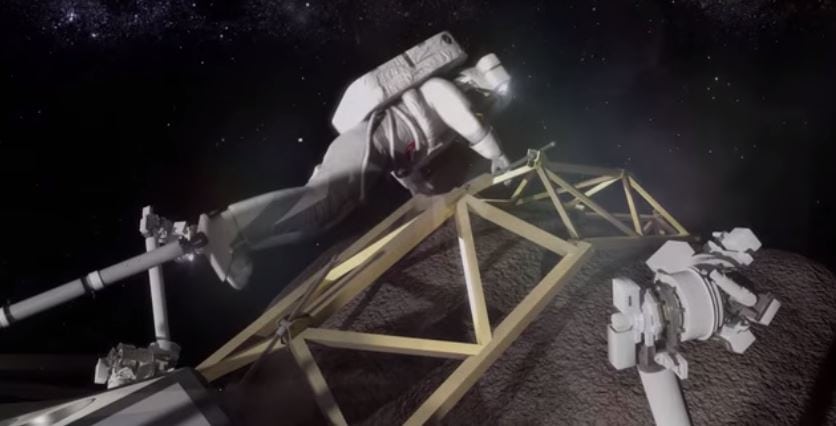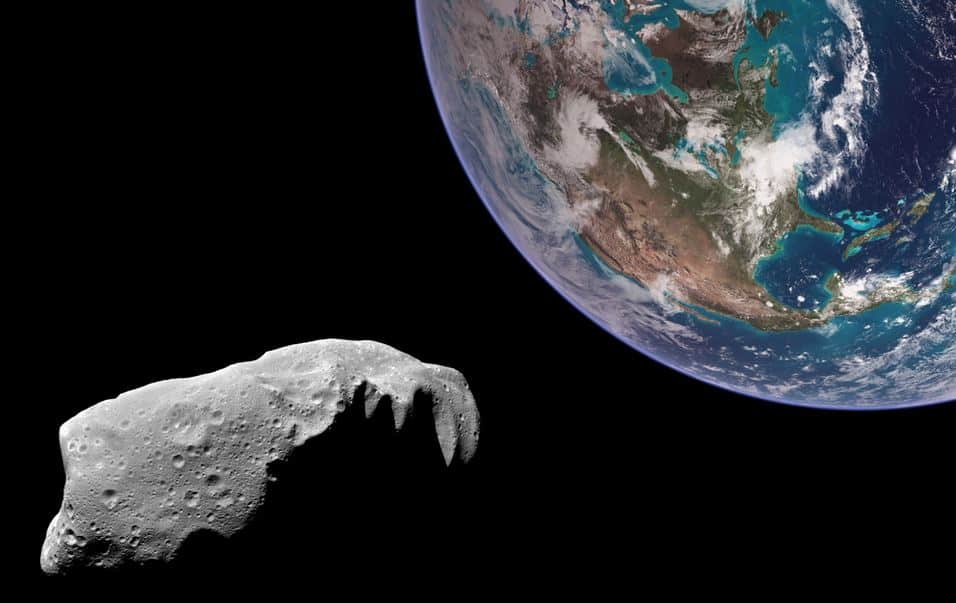NASA’s Asteroid Redirect Mission aims to grab a large boulder from the surface of a nearby asteroid, and then place into a stable orbit around the Moon so that astronauts can explore and study it. All this would be in preparation for a future mission to Mars.
The mission, which is planned for 2020, aims to test several new capabilities required for future human expeditions into deep space, including the Red Planet, says NASA.
Since launching its asteroid initiative three years ago, NASA says its detection of near-Earth asteroids has increased by 65%.

The asteroid boulder will be placed into a Moon orbit. Astronauts will visit it, take samples, and bring them back to Earth. (Image: From NASA video)
NASA Associate Administrator, Robert Lightfoot, said:
“The Asteroid Redirect Mission will provide an initial demonstration of several spaceflight capabilities we will need to send astronauts deeper into space, and eventually, to Mars.”
“The option to retrieve a boulder from an asteroid will have a direct impact on planning for future human missions to deep space and begin a new era of spaceflight.”
Target asteroid will be selected in 2019
The US space agency says it won’t be until 2019 that it plans to announce which asteroid will be selected for the mission – about one year before the robotic spacecraft is launched.
Before considering a valid candidate for the mission, scientists must first determine a number of characteristics, including its size, shape, rotation and precise orbit.
So far, NASA has identified three possible candidates for the mission: 2008 EV5, Bennu and Itokawa. Leading up to the mission, it expects to add one or two asteroids each year to the list.
When the uncrewed ARM spacecraft reaches its target asteroid, it will deploy robotic arms to grab a boulder from its surface. It will then start a multi-year journey to redirect the large rock into orbit around the Moon.
Solar Electric Propulsion
During the mission, the ARM robotic spacecraft will test a range of capabilities required for future human missions, including advanced SEP (Solar Electric Propulsion).
SEP takes advantage of electricity and magnetism to push a craft through space. The spacecraft’s solar panels generate electricity, which gives a positive electrical charge to atoms inside the chamber. Magnetism pulls the atoms towards the back of the ship, which are then pushed by magnetic repulsion out of the ship (as occurs when you hold the same pole of two different magnets close to each other). This steady stream of atoms leaving the spacecraft gives it the thrust required to move forward through space.
This type of propulsion can move huge cargoes very efficiently. It is slower than conventional chemical rocket propulsion, but requires considerably less propellant and fewer launches to support exploration missions involving humans, which could reduce costs significantly.
Future spacecraft powered by SEP could pre-position vehicles and cargo for future human missions into deep space, either awaiting astronauts at Mars or staged around a moon as a stopping place for expeditions to the Red Planet.
The SEP-powered robotic spacecraft will test new navigation and trajectory techniques in deep space, working with the gravity of the Moon to place the asteroid’s boulder in a stable lunar orbit called a distant retrograde orbit.
“This is a suitable staging point for astronauts to rendezvous with a deep space habitat that will carry them to Mars,” NASA explains.
Testing planetary defense techniques
Before the asteroid boulder is moved to lunar orbit, the US space agency plans to test planetary defense techniques to help mitigate future potential asteroid impact threats.
During this mission, NASA hopes to gain the experience and knowledge required to help develop options to make asteroids heading for Earth change course, if and when that becomes necessary.
NASA’s Deep Impact comet science mission tested technology in 2005 that could help in changing the course of an Earth-bound object using a direct hit with a spacecraft.
The ARM robotic spacecraft opens a second option for defending Earth using a technique called gravity tractor. By holding a halo orbit in the appropriate direction after rendezvousing with an asteroid, the spacecraft can slowly pull the asteroid (with gravity) without touching it.

NASA detected 1,472 near-Earth asteroids in 2014.
Put simply, by orbiting the asteroid in a certain way, the spacecraft’s gravity could set the asteroid on a slightly different course so that it would not hit Earth.
If the spacecraft captured a large boulder on the asteroid’s surface, it would then have more mass, and would thus exert a greater gravitational force when in orbit.
Astronauts to visit Moon-orbiting boulder
NASA wrote:
“It will take approximately six years for the ARM robotic spacecraft to move the asteroid mass into lunar orbit. In the mid-2020s, NASA’s Orion spacecraft will launch on the agency’s Space Launch System rocket, carrying astronauts on a mission to rendezvous with and explore the asteroid mass.”
“The current concept for the crewed mission component of ARM is a two-astronaut, 24-25 day mission.”
The crewed mission will also test several capabilities required to advance human missions into deep space, such as to Mars and elsewhere, including a docking system that will connect Orion to the robotic spacecraft holding the asteroid boulder.
The astronauts will carry out spacewalks to study and collect samples of the asteroid boulder wearing new spacesuits specially designed for deep space missions.
Gathering these samples will help astronauts as well as mission managers determine the best way to secure and safely return samples from Mars in future missions.
The asteroid samples will be brought back to Earth, where they will be examined by scientists and also commercial entities interested in future asteroid mining.
Jim Green, director of NASA Planetary Science, said:
“Asteroids are a hot topic. Not just because they could pose a threat to Earth, but also for their scientific value and NASA’s planned mission to one as a stepping stone to Mars.”
So far, NASA has identified over 12,000 Near-Earth Objects (NEOs), including 96% of near-Earth asteroids bigger that 1 kilometer (0.6 miles) in size. It has not detected any objects of this size that could pose an impact threat to Earth in the next one hundred years.
However, smaller asteroids do pass fairly close to Earth, and some of them could pose an impact threat. A total of 893 near-Earth asteroids were found in 2011, this number increased to 1,472 in 2014.
NASA Video – Asteroid Ridirect Mission
